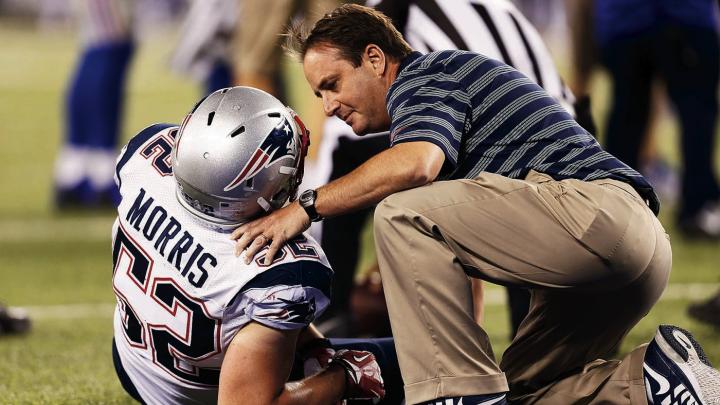A crushed nose, a snapped collarbone, a finger jabbed in an eye that drew blood: these were the minor injuries sustained at 1894’s brutal rendition of the Harvard-Yale football game. One tackle took a blow to the head so hard, his teammates had to point him to the correct goal before each play. He later fell unconscious for five hours—no thanks to the medics who carried him off the field, dumped him onto a pile of blankets, and resumed watching the match. Before it was over, at least four more players were hospitalized in (newspapers claimed) “dying condition.” Afterward, fans brawled in the streets of Springfield. Public outcry against the on- and off-field violence threatened to end football for good.
Adding more safety rules and protective equipment, the sport has come a long way since—and in 2013, the National Football League Players Association chose Harvard to lead research into the medical needs of its athletes. The 10-year, $100-million Football Players Health Study (FPHS) is recruiting 1,000 retired players [Updated June 17, 2015, 5:00 p.m.: Harvard Medical School advises that the study duration and cost are in flux and have not been publicly revised since the project was announced in 2013, and that the goal of the study, since it launched in 2014, is to reach as many of the estimated 20,000 former NFL players as possible; the originally announced goal was to recruit "at least 1,000 retired athletes."] in order to examine everything from physical ability to brain function; the project also involves a component in which law experts will draft ethics recommendations promoting player welfare. A third FPHS initiative will directly address the medical problems common among football players, by funding promising pilot studies.
One project, led by associate professor of orthopedic surgery Martha Murray, is developing a new surgery for ACL (anterior cruciate ligament) injuries. Murray had discovered that when this ligament tears, the knee joint’s lubricating fluid prevents healing, by dissolving any blood clots forming between the sundered ends; in response, a sponge scaffold can be sewn between them and loaded with collagen to promote re-growth. This new, less invasive method—boasting a shorter recovery time than the leading operation—has an unexpected benefit: the joint does not develop arthritis. “It was totally a surprise,” says Murray. Next, her team will compare how knees heal after sponge surgery, as opposed to graft reconstruction, to learn when, and why, the outcomes diverge. They have also received U.S. Food and Drug Administration approval to start their first human trials.
The players health study also funds the work of Aaron Baggish, a cardiologist at Massachusetts General Hospital, who has been gathering data on the cardiovascular health of first-year Harvard football players for 10 consecutive years. Every fall the athletes’ hearts tend to grow thick and stiff due to intense strength training, he notes; in the off-seasons, they become thinner and less stiff. “Stiff is not good when it comes to hearts,” Baggish explains. “The heart likes to be a supple, pliable structure.” He and his colleagues plan to follow the players as they return for alumni reunions, using cardiac MRIs to look for tissue scarring. Most Harvard footballers stop playing after graduation; they “de-train,” dramatically altering their exercise routines and lifestyles as a whole. Determining whether their hearts show signs of irreversible cardiovascular damage could have important implications for professional players, who have far lengthier careers.
A third pilot study addresses the health issue attracting the most public attention: repeated traumatic brain injuries (TBIs)—a class that includes concussions (head injuries that alter brain function) and contusions (bruising of the brain tissue). TBIs can lead to chronic traumatic encephalopathy (CTE), a degenerative brain disease. Through complementary work on humans and mice, researchers are testing a light therapy that shows potential to improve brain function after head injury. William P. Meehan III, assistant professor of pediatrics and orthopedics, is conducting a clinical trial in which concussion patients receive treatment three days a week, for six weeks, with red and near-infrared light directed at their skulls. He hypothesizes that this red light increases the metabolic activity of the cells, which in turn produce more ATP, a molecule that carries energy within cells, thus helping the brain recover.
His colleague Michael Whalen, a neuroscientist at Mass General, reports that if concussed rodents are treated with laser light immediately after an injury, testing an hour later shows “significantly improved cognitive outcome.” But his lab has also found that any therapy that improves cognitive outcome after a concussion might actually worsen it after a contusion. “If you lump all the patients together, you’re hurting some and helping others,” Whalen cautions. By studying mice, he hopes to gain insight into the molecular mechanism behind cognitive dysfunction, and find out why this occurs.
The next round of funded research projects begins this June. The winning proposals include a soft, “smart” knee brace that protects a player without limiting motion, and a new self-titrating drug-delivery system to relieve arthritis after injury. Other studies aim to prevent brain damage: an antibody therapy that removes the malformed proteins in the central nervous system that destroy brain cells, and a mobile scanning device that monitors the movement of athletes’ brains in real time, on the field.
“Let’s not kill football yet,” urge the study’s principal investigators, in a May editorial in the Pittsburgh Post-Gazette. But rather than wait for evidence about whether the sport is safe, they argue, “We need results fast to develop new diagnostic methods and treatments” for those already in the game. That way, even as football’s toll on its top athletes is being assessed, medical advances may allow players to experience what a Harvard Stadium plaque calls “the joy of manly contest”—with fewer of its dangers.









